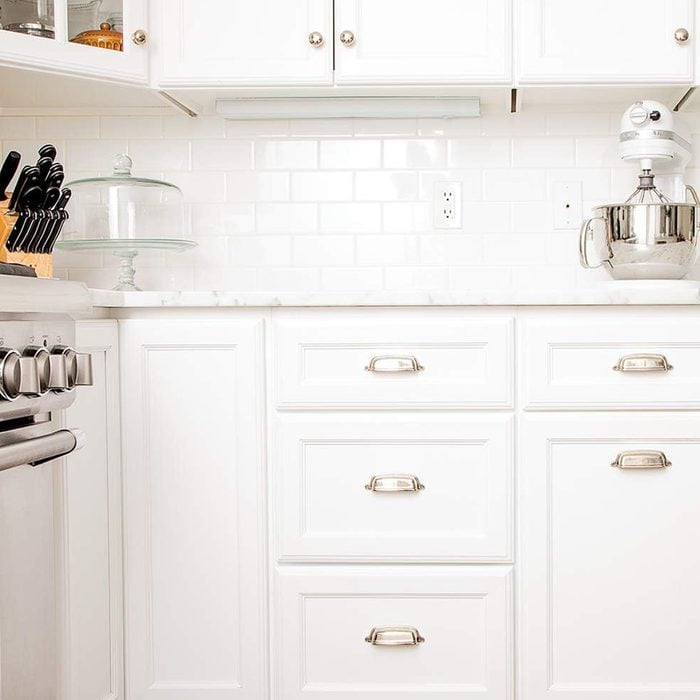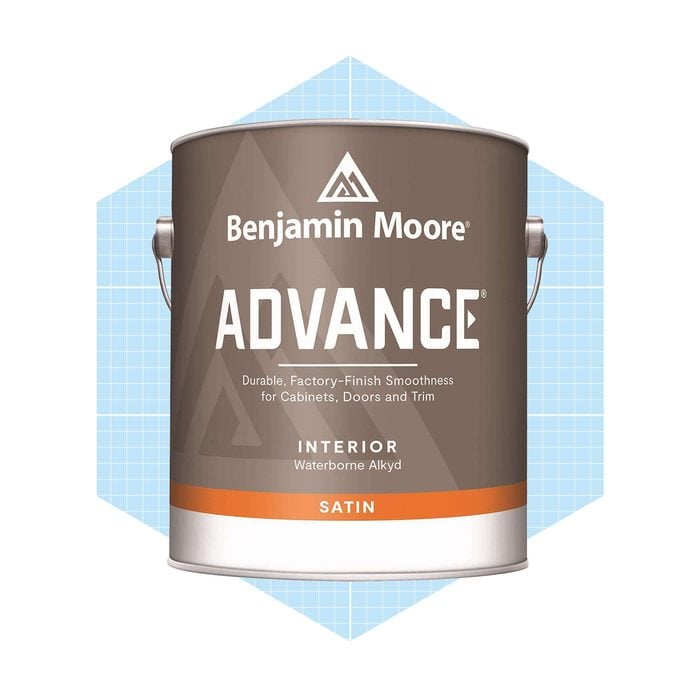
Overall Best Paint for Kitchen Cabinets
Benjamin Moore Advance
There are several reasons why we selected Advance Interior Paint by Benjamin Moore for the overall best paint for kitchen cabinets and why it also doubles as the best alkyd kitchen cabinet paint on the list. It combines the low VOCs of a water-based paint with the smoothness and durability of an oil-based paint in an alkyd-enhanced hybrid. Advance gives a choice of finishes, including matte, satin, semi-gloss and high-gloss.
We recommend the satin finish, which provides luster while retaining some ability to hide flaws. Professional painters like the way the paint smooths itself as it sets and the hard, washable, furniture-grade finish it provides. Benjamin Moore provides a comprehensive tutorial video for best application practices and other painting tips.
Pros
- Goes on smooth and covers imperfections
- Cleans easily with soap and water
- Durable, smooth satin finish
- Low VOC
Cons
- Pricey
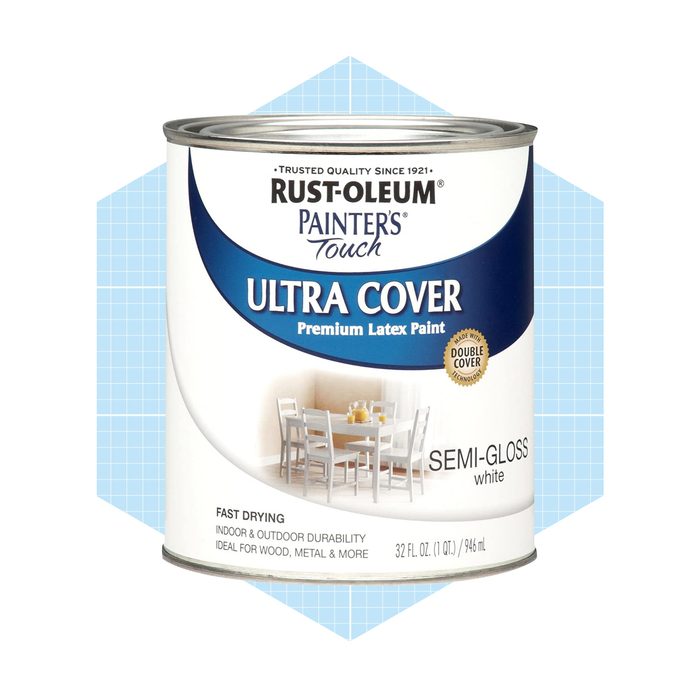
Best Latex Paint for Kitchen Cabinets
Rust-Oleum Painter’s Touch
Rust-Oleum Painter’s Touch provides a finish that withstands wear and tear and goes on in fewer coats. Because it dries to the touch in under 30 minutes, there’s no need to stay out of the kitchen for hours while it sets.
The paint comes highly recommended from professionals for painting and refacing kitchen cabinets, but they warn that using the wrong brushes and rollers or poor technique yields subpar results with spotty coverage and brush marks. Take your time and do it by the book when using this paint (including the appropriate cure time) and you’ll get professional results. Sheens run from satin to gloss.
Pros
- Low odor
- Chip-resistant
- Dries to touch in 30 minutes
- Huge selection of colors and finishes
Cons
- A prewash with degreaser recommended for best staying power
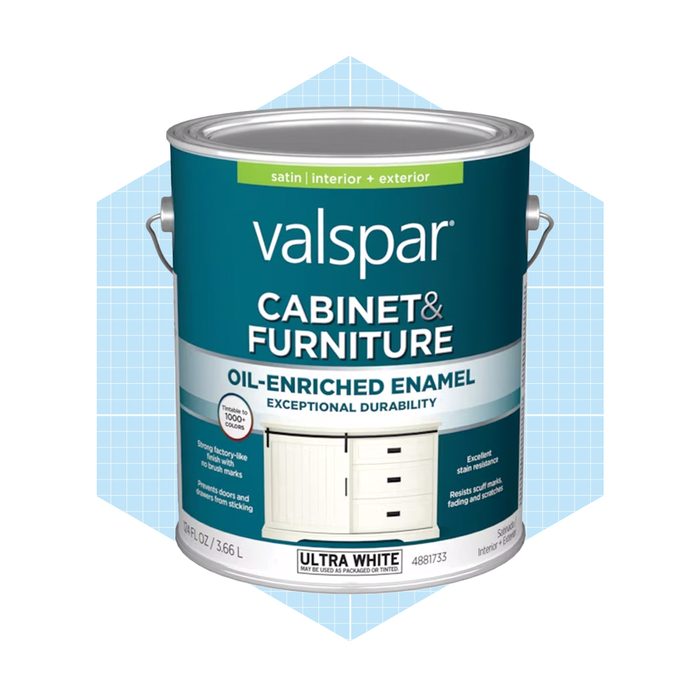
Best Oil-Based Paint for Kitchen Cabinets
Valspar Satin Base Cabinet Enamel Paint
When painting kitchen cabinets, the best paint is one that’s consistently easy to apply. Valspar Satin Base Cabinet Enamel Paint is a traditional oil-based paint that when fully cured (21 to 30 days), provides a harder, more durable finish than latex or acrylic paints.
This paint makes it less likely you’l have to make repairs to the surface of your kitchen cabinets. As an oil-based, high-quality paint, it also provides superior leveling (fewer brush marks) and coverage properties. Achieve the best results from practicing patience and applying two to three coats for a long-lasting finish.
Pros
- Self-leveling formula prevents brush marks
- Oil-enriched enamel prevents sticking doors
- Stain, scuff, fade and scratch-resistant
- Comes in 1000+ colors and several finishes
Cons
- Pricey
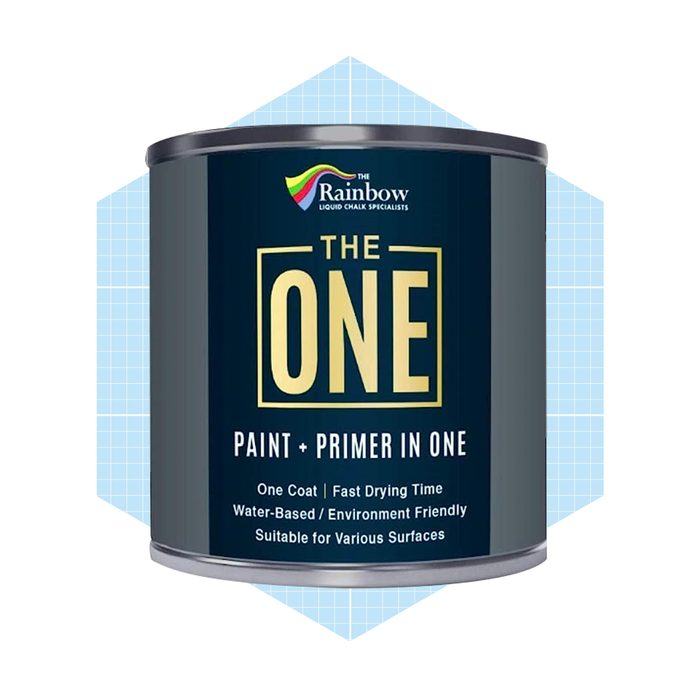
Best Budget Cabinet Paint
The One Cabinet Paint and Primer
At under $25 for 8.5-ounces, there’s no better deal than The One’s Cabinet Paint and Primer. While the container may seem small, a little goes a long way thanks to little-to-no prep work and smooth coverage in just 1-2 coats. The secret behind the thick, high-coverage formula is opaque water-based pigments.
Not only does using this paint get the job done quicker, but it dries to a durable, washable finish that resists dirt and grime. That includes airborne oil particles and food splatters, among other kitchen-related messes.
Pros
- Opaque formula contains a built-in primer
- Covers most wood and laminate cabinets in 1-2 coats
- Comes in gloss, satin and matte finishes
- 12 colors available
- Low VOC
Cons
- 8.5-ounce can may not be enough for bigger kitchens
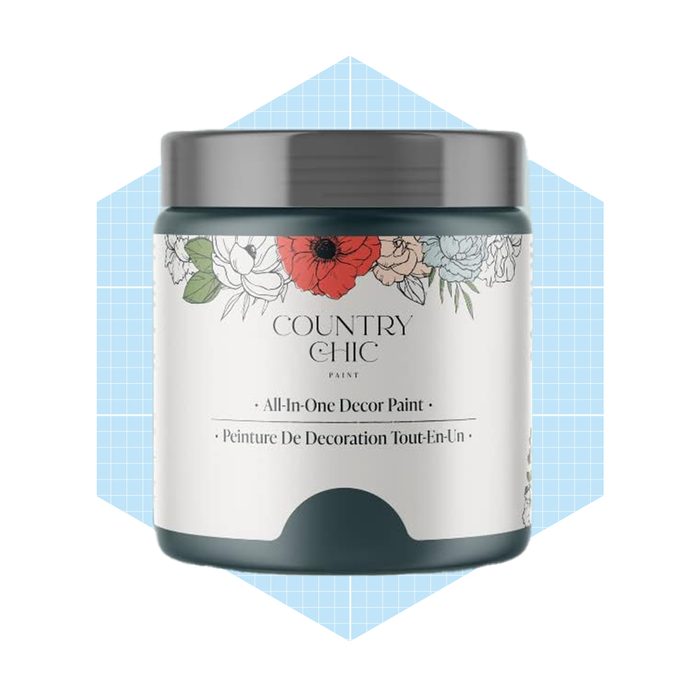
Best Low-VOC Paint for Kitchen Cabinets
Country Chic Eco-Friendly Paint
For a colorful kitchen, consider a can of Country Chic Eco-Friendly Paint. Apart from the selection of more than 50 vibrant hues, this chalk paint includes very low VOCs, making it safe for use indoors. A built-in primer and top coat ensure that the finish sticks to the surface of both wood and laminate cabinets, without the need to strip and sand.
While wax, sealants and top coats aren’t necessary, we recommend applying something like Jolie Finishing Wax on top unless you’re going for a distressed, vintage look. Because of the self-leveling formula, it disguises brushstrokes and makes the paint virtually “goof-proof.”
Pros
- Paint dries within 30 minutes
- Ultra-low VOC and no harsh chemicals
- Little to no scent
- Includes built-in primer and top coat
Cons
- Wax and sealants are optional, but recommended
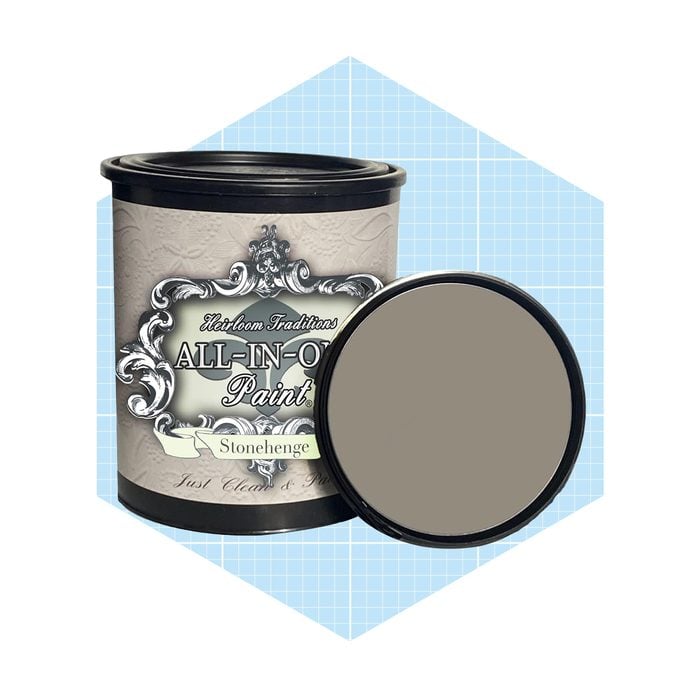
Best Paint With Primer for Kitchen Cabinets
All-in-One Primer Paint
It may sound too good to be true, but self-priming paint can save hours of your time. Not only is it self-leveling and chip-resistant, but All-in-One’s Primer Paint offers full coverage without the need for sanding, priming or top coats on most surfaces. A low luster, velvet-sheen finish disguises uneven surfaces and the fast-drying formula is ideal for high traffic areas like kitchens.
While darker cabinets (or lighter paint colors) will require 2-3 coats for full coverage, lighter cabinets and darker shades can get away with only one coat. It won’t be ideal for every surface, but porous surfaces like wood cabinets easily hold onto the pigment. That means a chip-resistant finish without the need for yearly waxing or odorous top coats.
Pros
- No sanding, priming or top coat required
- Doesn’t require yearly waxing
- Chip-resistant finish
- Low-odor
- Works for most surfaces, including laminate, wood, counter, ceramic and fabric
Cons
- Lighter colors may take 2-3 coats to fully cover
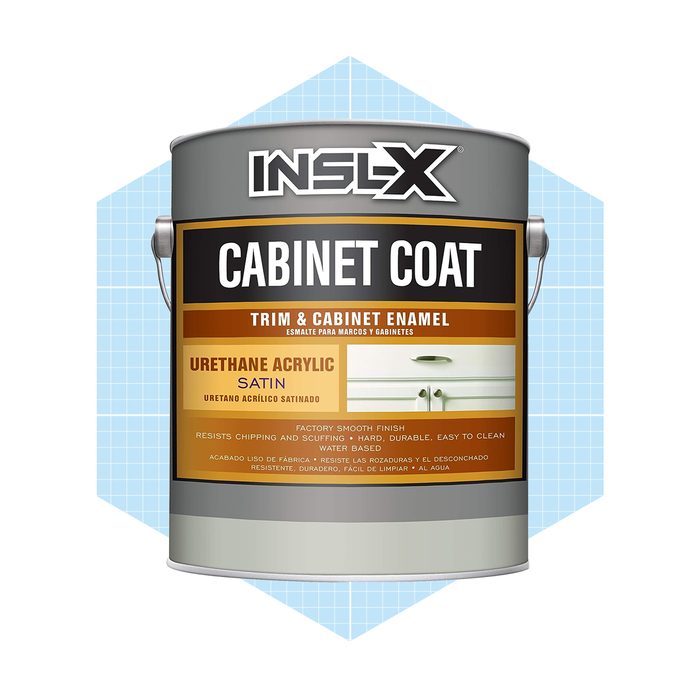
Best Acrylic Paint for Kitchen Cabinets
Insl-X Cabinet Coat Enamel
Looking for a classic, streak-free white? Because it’s specifically formulated for cabinets, Insl-X Cabinet Coat Enamel offers a factory-smooth finish that easily adheres to laminate and wood surfaces. Simply use a short nap roller, brush or sprayer to apply 2-3 thin coats after prepping and sanding your cabinet surfaces.
Unlike other formulas, the acrylic-based formula makes it easy to wipe down in the event of grease, water or food splatters without worrying about chips and scuffs. When layering this paint, be sure to wait at least 6 hours between coats and remove all cabinet hardware for the smoothest possible finish.
Pros
- 350-450 square foot coverage per gallon
- Easy to clean
- Resists chipping, scuffing, food stains, grease and water
Cons
- Expensive
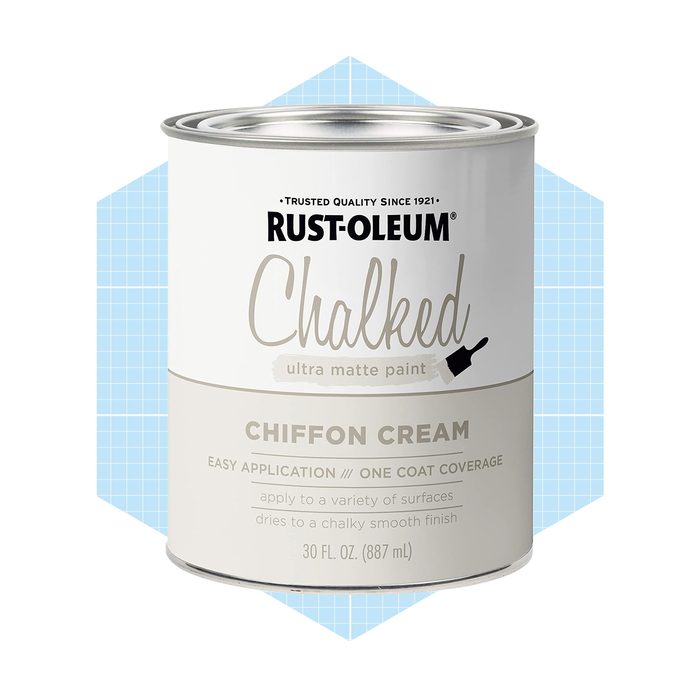
Best Chalk Paint for Kitchen Cabinets
Rust-Oleum Ultra Matte Interior Chalked Paint
For a completely different look on your kitchen cabinets, you can choose a chalk-based paint. We recommend splurging on this ultra-matte version by Rust-Oleum The ultra-matte finishes offer the flexibility of creating an aged, burnished or distressed look easily with minimal preparation.
No one will argue with the fact that for painting projects, the better your surface prep, the better the finished product. But Rust-Oleum developed this paint to create a more-than-acceptable finish without the heavy prep. Keep in mind that chalk paint will not provide a durable enough finish for cabinets without a hard, wax topcoat.
Pros
- Ultra-matte finish
- Low-odor, latex formula
- Covers up to 150 sq. ft
- Works well for distressed, antique looks
Cons
- Requires a hard topcoat to seal paint
What to Know About Kitchen Cabinet Paint
When it comes to painting cabinets, prep is equally as important as the type of paint. “We recommend sanding the surface of the cabinets prior to the paint application to ensure proper adhesion and smoothest results,” says Underwood. He also notes that a flat painting surface with enough room to work is key, ensuring enough space to lay the cabinet doors flat after removal from the hinges.
“Ideally, your work space will also allow room to leave the pieces to dry for extended periods of time and have good air circulation, which will help speed up the dry time. Label your hardware, such as hinges and handles, to make reassembly much easier.”
Once you settle on the type of paint, you’ll want to make sure you purchase enough to finish the job. “The amount of paint you need will depend on how much surface area you’re looking to cover and how many coats you’ll apply,” says Underwood. “Generally speaking, you should plan for two coats.”
When it comes time to clean painted cabinets, soap and water is an effective means of removing built-up grease and food stains. “As long as the paint has dried and fully cured per label instructions, you can clean painted cabinets with a solution of warm, soapy water and a cloth or sponge,” he says.
Why You Should Trust Us
Emily Way is an associate shopping editor for Family Handyman with experience researching products and recommending the best designs to consumers. She researched and updated this piece. Way consulted David Underwood, Associate Technical Project Manager at Benjamin Moore.
How We Found the Best Kitchen Cabinet Paint
At Family Handyman, we’re not just locating the best products for DIYers—we’re also committed to finding products that pass the discerning gaze of seasoned home experts. In order to find the best kitchen cabinet paint, we spoke with paint experts from Benjamin Moore and learned about the properties they look for when formulating cabinet paints.
Then, we analyzed over 20 top-selling paints in different formulations and finishes, ensuring there’s a product pick for every application. To do so, we first combed through leading home improvement stores and Amazon to locate best-selling paints. Then, we dove deeper, looking into reviews to see how each product performs to ensure that our picks resist heat, grease, food splatters and won’t make cabinets stick.
FAQ
What is the best paint to use on cabinets?
Underwood says that a paint’s base composition determines how well it will perform. Choose a waterborne-alkyd if you’re looking for something that cures to a durable, furniture-like finish. Those looking for a smooth, factory-like finish should opt for urethane/acrylic hybrids.
What is the best paint for shiny kitchen cabinets?
For shiny cabinets, consider a semi-gloss. However, it’s best to stick to more matte finishes when painting older or worn cabinets. “Keep in mind that the higher the sheen, the more light it will reflect, which also will accentuate any imperfections on the surface,” warns Underwood.
Do I need to prime cabinets before painting?
The more prep work put into a painting project, the better the outcome. Underwood recommends priming and sanding the surface of the cabinets prior to the paint application to ensure proper adhesion and smoothest results.

